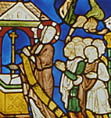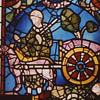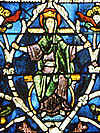![]() Painted glass
Painted glass
 The
earliest painted glass of the post-Conquest period in England dates from the
second half of the 12th century and the largest collections are in Canterbury
cathedral and York Minster.
The
earliest painted glass of the post-Conquest period in England dates from the
second half of the 12th century and the largest collections are in Canterbury
cathedral and York Minster.
Glass was made from sand and a number
of other materials including wood ash. The painted details were applied to the
surface of the glass with a brush using pigments made from metal oxides mixed
with powdered glass and gum arabic. Each piece of painted glass was  fired
in a kiln at about 700° so as to fuse the pigment in place. The pieces were
then fitted together with lead strips to complete the window.
fired
in a kiln at about 700° so as to fuse the pigment in place. The pieces were
then fitted together with lead strips to complete the window.
 At
York Minster over 50 panels of Romanesque glass survive, although not in their
original windows. Eight or more iconographic series are represented, the
themes including the Last Judgement and lives of the saints. The style of
painting reflects the influence of both northern French and local artistic
traditions; for example the rendering of the human figure is similar to that
seen in sculpture from St Mary's Abbey in the city.
At
York Minster over 50 panels of Romanesque glass survive, although not in their
original windows. Eight or more iconographic series are represented, the
themes including the Last Judgement and lives of the saints. The style of
painting reflects the influence of both northern French and local artistic
traditions; for example the rendering of the human figure is similar to that
seen in sculpture from St Mary's Abbey in the city.
 At
Canterbury a major glazing programme took place in 1184 - 1220 in the Trinity
Chapel and Corona, built after the fire of 1174. Some of the glass is in its
original position including parts of two windows in the north choir aisle
which include scenes from a popular medieval text, the Biblia Pauperum
(poor man's bible) which demonstrated how events of the Old Testament anticipated
events in the New. There is also a window showing part of a Tree of Jesse,
thought to have been a gift from Richard I.
At
Canterbury a major glazing programme took place in 1184 - 1220 in the Trinity
Chapel and Corona, built after the fire of 1174. Some of the glass is in its
original position including parts of two windows in the north choir aisle
which include scenes from a popular medieval text, the Biblia Pauperum
(poor man's bible) which demonstrated how events of the Old Testament anticipated
events in the New. There is also a window showing part of a Tree of Jesse,
thought to have been a gift from Richard I.